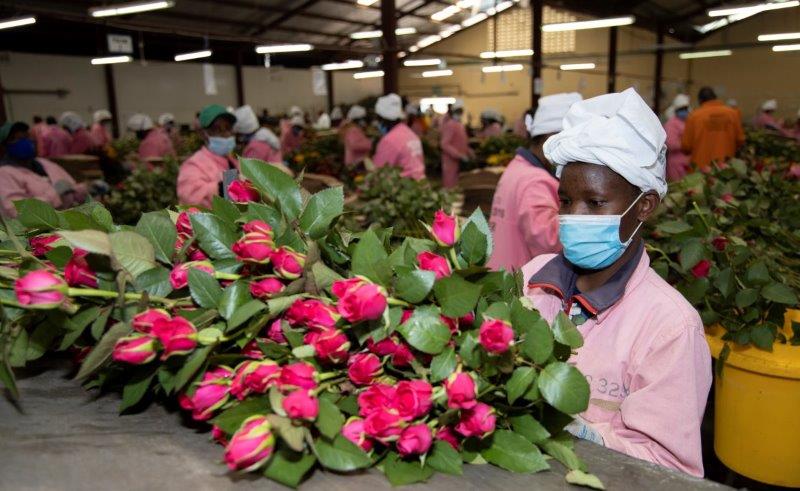
Kenya’s flower industry has been among the country’s top exports for years, and new projections suggest the sector is only set to grow stronger. According to recent market estimates by Mordor Intelligence, Kenya’s floriculture industry recorded sales of about USD 835 million in 2024. The sector is projected to grow to USD 1.1–1.15 billion in 2025 and expand further to about USD 1.4–1.5 billion by 2030. The forecast also indicates a steady expansion, with the compound annual growth rate (CAGR) estimated at 4.9% to 5.2%.Behind those numbers, however, lies a deeper story about adaptation, trade policies, and a balancing act between costs, sustainability, and global demand.
Why Kenya’s Flowers Remain Competitive
Few countries can match Kenya’s natural growing conditions. High-altitude farms around Naivasha and the Rift Valley benefit from cool nights that naturally regulate greenhouse temperatures. Unlike growers in Europe who spend up to 40% of their production costs on heating and lighting, Kenyan producers save both money and carbon emissions thanks to the equatorial climate. Some farms, like Oserian, have gone further by tapping into geothermal steam, cutting their annual energy bills by nearly a quarter while also appealing to sustainability-conscious buyers.
These advantages help explain why Kenya still dominates the global cut-flower trade, even as production costs rise. Logistics remain one of the thorniest issues, with transport accounting for nearly 60% of the total cost of getting a stem from farm to florist. But even here, the industry is innovating, the slow but determined shift from air freight to sea freight is beginning to reshape the economics of exports. Trials of refrigerated sea containers that can keep flowers fresh for days have already slashed logistics costs by as much as 70%, though the shift demands varieties that can withstand longer transit. Roses and hypericum bred for vase life are at the front of this transformation.
Changing Market Conditions
Policy developments are also shaping the industry’s outlook. Duty-free access to the European Union under the EU-Kenya Economic Partnership Agreement provides a vital edge, while the UK’s suspension of its 8% tariff on Kenyan flowers through 2026 has added fresh breathing space. For smaller farms that often operate on thin margins, saving even USD 0.08 per stem makes the difference between survival and decline.
Still, uncertainty lingers as some of these trade concessions are temporary, leaving exporters wary of making long-term investments in infrastructure or expanding acreage. As the Kenya Flower Council noted, streamlined procedures and reliable phytosanitary standards are critical to ensuring that Kenyan flowers don’t just enjoy short-term openings, but secure a lasting foothold in global markets.
Roses hold the top spot in Kenya’s exports, making up nearly two-thirds of all flowers shipped abroad although other varieties are catching up. Hypericum, once seen mainly as a filler flower, is growing at an expected 5.2% annually, driven by the Middle East wedding market where it has moved from a supporting role to a central design element.
Gypsophila, limonium, lilies, and carnations each have their niches. Carnations still appeal to price-sensitive northern European buyers, though they face stiff competition from Colombia. Specialty flowers like veronica, though produced in small volumes, command premium prices among florists seeking differentiation. The diversification of Kenya’s flower portfolio not only spreads risk but also taps into new consumer tastes across Asia and the Middle East.
Challenges That Can’t Be Ignored
Pest infestations, such as the persistent False Codling Moth (FCM), continue to pressure farms, raising pesticide costs and attracting scrutiny from regulators and environmental groups. Social compliance is another rising burden: European supermarkets increasingly require certifications that guarantee workers receive living wages and better conditions. While large farms often absorb these costs and reap the benefits of premium market access, smaller producers risk being pushed out of the export game.
Water use remains the most contentious issue of all. Lake Naivasha, has seen heavy monitoring of abstraction levels, with authorities considering tighter usage caps. Producers are responding by investing in drip irrigation, water-recycling ponds, and efficiency technologies, but the debate over flowers versus freshwater sustainability will only intensify.
The Kenyan floriculture sector faces immense pressures, from currency swings to social audits, yet it continues to thrive, adapt, and even expand its footprint in new markets. The UAE and the wider Middle East are emerging as the fastest-growing buyers, while the European Union remains the anchor. Domestically, Eldoret International Airport could become a game-changer for western Kenya farms if freight routes develop, easing dependence on Nairobi’s congested logistics hub.
Ultimately, the outlook remains positive. Kenya’s combination of climate advantage, shifting logistics strategies, and preferential market access provides a foundation for growth, but maintaining competitiveness will demand more than just natural advantages. It will require investments in sustainable practices, stronger integration of smallholders into export chains, and a forward-looking strategy that treats challenges like water scarcity and social compliance not as burdens, but as opportunities to lead.
Source: Mordor Intelligence
